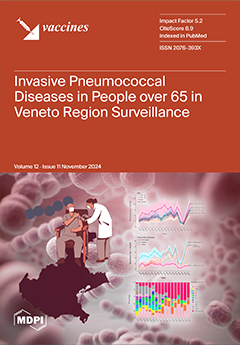Background: Serosurveillance of epidemic cerebrospinal meningitis (ECM) in healthy individuals is crucial for assessing disease risk and evaluating the effectiveness of vaccinations. However, this practical work is rare in China.
Methods: We conducted cross-section serosurveillance in Guangzhou, Zhanjiang, and Heyuan in
[...] Read more.
Background: Serosurveillance of epidemic cerebrospinal meningitis (ECM) in healthy individuals is crucial for assessing disease risk and evaluating the effectiveness of vaccinations. However, this practical work is rare in China.
Methods: We conducted cross-section serosurveillance in Guangzhou, Zhanjiang, and Heyuan in Guangdong Province, measuring Anti-Nm IgG with serogroups A, C, Y, and W, and analyzed the trends using a generalized additive model (GAM).
Results: During 2019–2022, 7752 participants were included. The overall antibody positivity rate for serogroups A, C, Y, and W were 60.75%, 15.51%, 32.83%, and 14.56%, respectively. High Anti-Nm IgG was in children aged 0–5 and 5–10 years old. Geometric mean concentrations (GMCs) of Anti-Nm IgG were higher and correlated positively with vaccine doses compared with unvaccinated individuals. The GMC showed a consistent decrease trend in the vaccinated and a U-shaped curve in populations. The declined rates of GMC were 1.59 (95% CI: 1.03, 2.14) µg/mL, 1.65 (95% CI: 1.28, 2.03), 0.62 (95% CI: 0.22, 1.03), and 0.31 (95% CI: 0.08, 0.53) µg/mL per year for serogroups A, C, Y, and W, respectively.
Conclusions: There were differences in antibody positivity rate and GMC for the four serogroups of ECM in the healthy individuals of Guangdong Province, with serogroup A showing the highest, and the demographic differences highlighted the high seroprevalence of
Neisseria meningitidis in younger people. The variable prevalence rates among serogroups A, C, Y, and W and the observed decline in antibody titers underscore the need for adjustments in the immunization program targeting the meningococcal vaccine.
Full article






